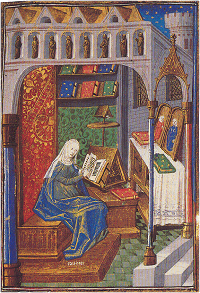
From rags to riches, or how undergarments improved medieval literacy
Thought the invention of the printing press led to an upsurge in literacy rates in the later Middle Ages? Wrong, according to some historians of communication, who believe that paper was more important than printing.
“The development of literacy was certainly helped by the introduction of paper, which was made from rags,” says Dr Marco Mostert, a historian at the Centre for Medieval Studies, Utrecht University and one of the organisers of this year’s International Medieval Congress at the University of Leeds.
“These rags came from discarded clothes, which cost much less than the very expensive parchment which was previously used for books. In the 13th century, so it is thought, as more people moved into urban centres, the use of underwear increased – which caused an increase in the number of rags available for paper-making.”
Speaking at this year’s IMC, which runs from 9 to 12 July, Dr Mostert said that literacy was more common in the Middle Ages than is popularly thought. “Although the aim of producing a 100% literate population didn’t occur before the 19th century, after about 1100 the need for literacy grew steadily, and from about 1200 onwards the number of literates increased dramatically along with the number of schools in urban areas.”
Yet even in countries where there were few or no towns and, therefore, schools, such as Iceland, the literacy rate continued to grow rapidly. “Many people learnt to read at home, usually from their mothers,” says Dr Mostert. “The role of female literacy in the home has been underestimated until quite recently.”
So what would have made it onto a medieval bestsellers’ list? The Bible and parts of the Bible, such as Psalters, as well as prayer books and religious poetry, consistently topped the charts. History was popular, too: the stories about Roman emperors collected by Valerius Maximus still survive in around 400 copies. Geoffrey Monmouth’s history of the kings of Britain can be found in 200 remaining copies.
Writers were as desperate to get their work published in medieval times as they are now. As books were exclusively hand-written until the invention of the printing press around the middle of the 15th century, publication sometimes meant reading your text aloud to a public that was lavishly entertained - at your expense. “Gerald of Wales had his Topography of Ireland read out in Oxford during three days,” laughs Dr Mostert. “He spent a fortune, and still didn’t make the top ten.”
Discarded or outdated editions of books were put to good use. They were made into binding materials for new books, or, after Henry VIII dissolved the monasteries in the 16th century, into kites or covers for jars.
Urban literacy is just one of the topics being covered at this year’s IMC, which has as its focus medieval cities in Europe and neighbouring territories to coincide with the 800th anniversary of the foundation of the borough of Leeds..."
Además, la Dra. Jane Chance, Universidad de Rice, ha trabajo sobre la escritura hecha por muchas mujeres en la Edad Media.
La ciencia, y los avances de la historia, no dejan de sorprender...



No hay comentarios.:
Publicar un comentario